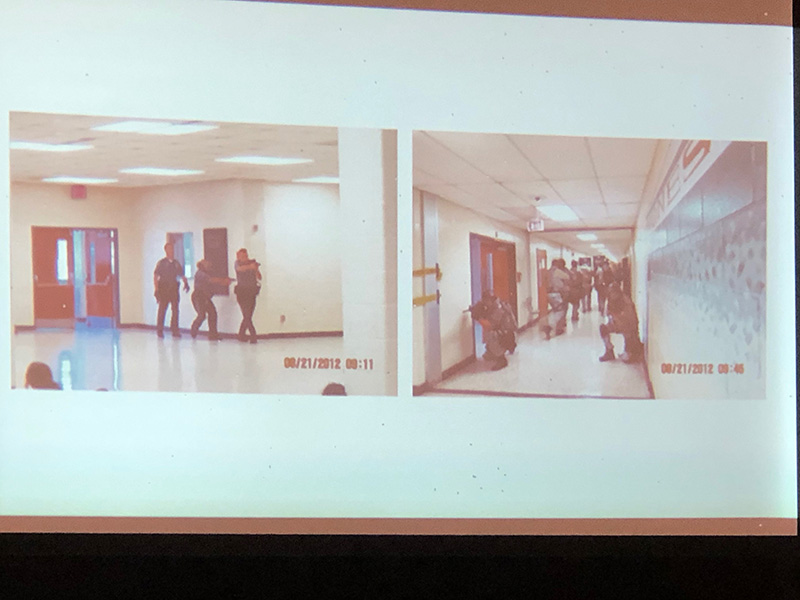
BRICK – What would you do if you suddenly heard gunshots while you were at your workplace, house of worship, a concert, a nightclub, a healthcare facility, or anywhere else there have been active shooters?
Startled by the sound of gunfire, most people freeze, said Brick Police Detective Tim McCarthy, who presented a Critical Incident/Active Shooter Response for Businesses program recently, which was co-sponsored by the Brick Chamber of Commerce.
Active shooter is a term used by law enforcement to describe a situation in which a shooting is in progress and implies that both the police and citizens have the potential to affect the outcome of the event, based upon their responses, the detective said.
“It’s unfortunate we have to do these kinds of events, but this is happening in our country and around the world,” McCarthy said during the event, which was held at the PAL building on Drum Point Road.
“Open your eyes, pay attention to what’s going on around you,” he said. “The faster you react, the better chance you and others will survive.”
McCarthy, who is a detective assigned to schools, and who is the municipal counter-terrorism coordinator, said he would not be teaching the audience tactics to “take people down,” but, rather, how to increase someone’s chance of surviving someone who “wants to kill others indiscriminately.”
[adrotate banner="278"]A semi-trained assailant can discharge a revolver at the rate of 18 rounds in 30 seconds, he said.
Most active shooter incidents end within five minutes, and some end within two minutes. Even when police are present or able to respond within minutes, civilians often have to make life or death decisions, and should therefore be engaged in training and discussions on decisions they may face, McCarthy said.
When possible, it’s best to run if the path is clear. “Don’t stop running, have your hands up and empty when you leave the building, then call the police and give them any information you can,” he said.
If you can’t escape, hide, he said, and lock the door, barricade it, stay close to the ground, turn the lights out and call 911, if possible, McCarthy said.
“If you’re confronted by the active shooter, fight for your life, search for objects that are heavy and sharp, and don’t hold back, don’t stop fighting until you know you’re safe,” he said.
For example, a fire extinguisher could be used in two ways: since it’s heavy you could use it to hit someone, or you could spray it as a distraction, he said.
“Fight, but only if you are comfortable doing that – but only as a last resort to save your life. Use 150 percent,” McCarthy said.
Help others if you can, but don’t let them hinder your escape, he added.
McCarthy said that businesses should design an evacuation plan for employees, which could make the difference between life and death. “Have a plan, practice your plan like fire drills.”

He said guns are not the only weapons being used to kill innocent civilians. He cited a 2017 attack on the London Bridge where a van was used to drive into pedestrians, followed by three armed men with knives who attacked people on the street.
Bombs are also being used to kill people, such as the explosion during the Boston Marathon in 2013, and a pipe bomb that was detonated in a garbage can at the start of a Marine Corps charity race in Seaside Park in September 2016.
Things started to change after the school shooting at Columbine and Virginia Tech, McCarthy said. “It’s happening way too often. It’s a sad state of affairs we have to live like this.”
The mindset of law enforcement is to save hostages and stop the shooter, he said.
There are some common traits among shooters, McCarthy said. Active shooter’s motives are often acts of vengeance and achievement of power or status. In most cases, the individuals are suicidal, homicidal and want to be killed. Many had recently undergone multiple psychological stressors, including rejection, discipline and humiliation.
“As a boss or a co-worker, you might start seeing some of these things. Ask that person, are you alright? If it’s a big company, bring it to HR. Say something, you could change the outcome,” he said.
Quite often a shooter will tell what they’re planning ahead of time through social media posts.
“Statistically, active shooters rarely plan past the initial action. When confronted, most shooters have trouble deviating from their planned path,” McCarthy said. “Throw them off their plan,” McCarthy said, which could be something as superficial as return fire.
After his presentation, which included a video that was produced by Homeland Security, McCarthy took questions from the audience.
[adrotate banner="277"]One person asked if active shooters use legal guns. McCarthy said most are legal. “They either get them from family members or they’ve gotten them legally in the past,” he said.
Another audience member asked what children should be taught without creating too much anxiety.
The detective said the schools hold one fire drill and one security drill a month, which include lockdowns.
“They know exactly what they have to do,” he said. “We don’t tell them it’s a drill, so we make it like it’s real every single time. It’s become second nature with kids.”






